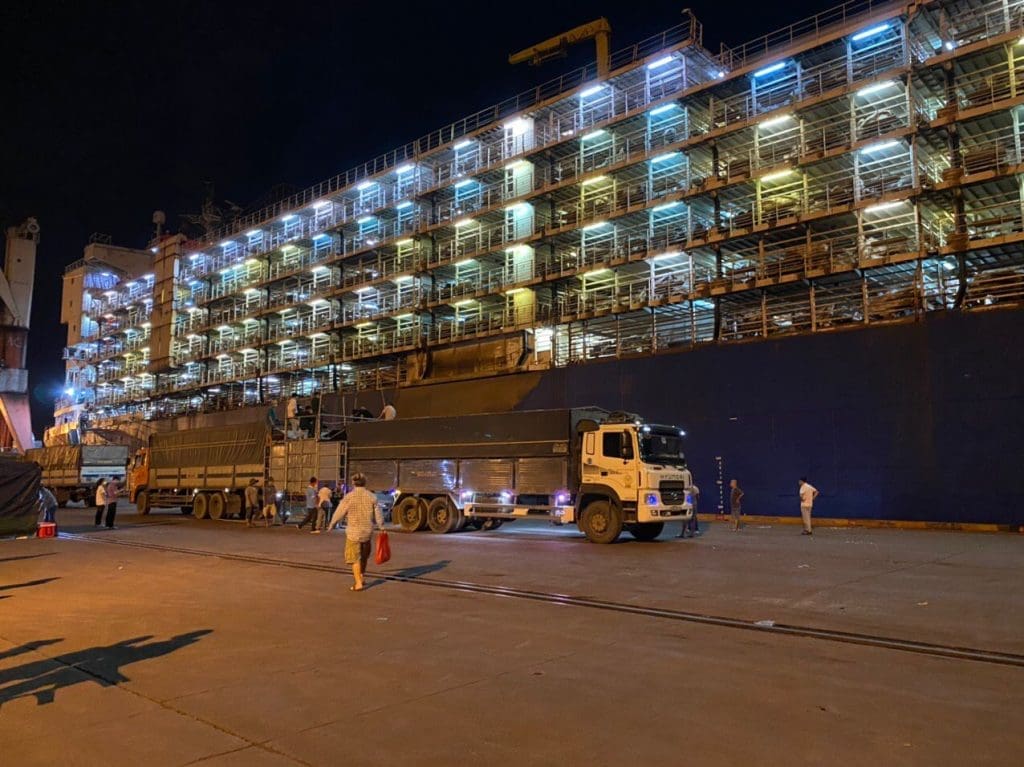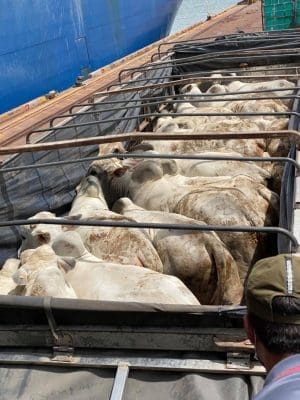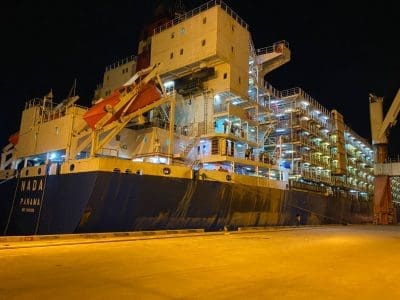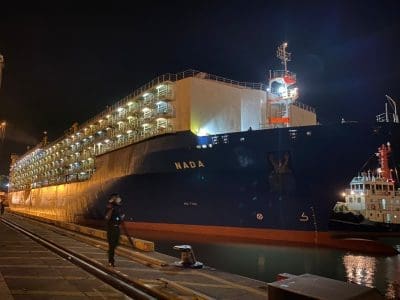
The MV Nada unloading at the Port of Thi Vai in Vietnam.
A second large shipment of Brazilian bulls is scheduled to take to the seas for Vietnam in December following the successful delivery of the first history-making consignment aboard the MV Nada last month.
The first shipment, which comprised close to 14,000 black and grey coated Nellore bulls weighing an average of 550kg, was discharged at the port of Thi Vai near Ho Chi Minh City in Southern Vietnam on September 23 and 24.

Brazilian bulls unloaded in Vietnam.
The trade-opening shipment, which establishes a second source of live cattle supply for Vietnam in addition to cattle from Australia, performed “very well”, according to parties involved.
Danny Fakhre, the owner of the MV Nada, told Beef Central this week that the 30 day voyage produced a mortality rate across the 14,000 head consignment of 30 head, or 0.25 percent, less than would be expected on a farm or feedlot in South America or Australia he said.
Weight loss on the 500kg bulls across the journey averaged below 5 percent, also lower than usual rates.
“The performance on board was very good,” Mr Fakhre said.
“Post-discharge the feedback we are getting is that the importer is very happy with the animals and that the authorities are very pleased with the way the cattle have travelled and what happened after discharge.”
Mr Fakhre is the ship owner and not the exporter and was unable to confirm the price involved.
However other sources who are understood to be familiar with the transaction have told Beef Central the price was US $3.20 CIF. That is said to be about US 25c lower than the best CIF price available for Australian slaughter steers or bulls at current market prices.
When additional local costs and charges are taken into account the real landed price arriving into the feedlot may have been nearer to US $3.50, some sources estimate. But that would still be cheaper than recent sales of cattle from Australia to Vietnam at quoted estimates of around US $3.70-3.80 CIF.

The MV Nada in Vietnam.
Cattle from Brazil also attract a 5 percent import tax upon arrival that is waived on Australian cattle due to regional trade agreements, but even with this disadvantage and higher freight costs, Brazilian cattle can still be landed in Vietnam at a cheaper price than Australian cattle which are at historically high price levels.
The transaction was facilitated by a well-known Vietnamese importer with several feedlots and abattoirs in south Vietnam and with many years of experience importing Australian cattle, working in partnership with an army company based in Ho Chi Minh City.
Mr Fakhre told Beef Central the importer has received a permit from the Vietnam Government to import 60,000 cattle from Brazil, which is the equivalent of four shipments aboard the Nada, one of the world’s largest livestock carriers.
He said it is expected that further import permits will be issued to other importers when authorities are comfortable that the initial shipments have been successful.
Second shipment in December
Mr Fakhre said the original idea was for four voyages to occur from Brazil to Vietnam consecutively.
However, he said the Vietnamese importer had requested the second shipment be delayed until December.
“Because of the Covid situation at the moment in Vietnam they have some restrictions so they have asked if we can perform a separate voyage in between,” he said.
“So they won’t have a consecutive shipment, but we believe they may take a second shipment in December.”
Other sources have told Beef Central that recent BSE detections in Brazil prompted Vietnamese authorities to extend the quarantine period by 45 days before the first cattle from Brazil can be processed.
Two cases of atypical BSE were formally confirmed in Brazil about one week after the first shipment departed enroute to Vietnam.

The MV Nada.
Commercial consequences of a 45 day delay would include deferment of commercial returns from the first shipment for the importing and exporting parties, and additional feeding costs for exporters for any cattle already assembled for the second shipment, which was to have occurred consecutively, but which will now be delayed by around six weeks.
Mr Fakhre said he did not believe the BSE detections played a role in delaying the second shipment, because the atypical BSE cases were detected in cattle in Brazil some 2000km away from Para State, where the cattle for the shipment originated.
“I don’t think the Vietnamese were overly concerned, they have had these cases before, which are atypical.
“The importers are monitoring the situation.
“What they did do is rather than have two ports of discharge which was the original plan, they decided to discharge all of the cattle in one port to have them all in one area to monitor them better.
“The main reason (for the delay) was with lockdown in Vietnam, all the restaurants were closed, the consumption of beef was down so it was more a commercial decision.”
The MV Nada has left Vietnam and is currently heading for the Suez Canal.
Mr Fakhre said the Nada may do a voyage carrying South American beef cattle to the Middle East or South American dairy cattle to China before returning to Brazil to load the second shipment of bulls for Vietnam.
The first shipment from Brazil to Vietnam has been closely watched by the Australian live cattle trade, which until now has been the only approved supplier of live cattle to Vietnam.
Mr Fakhre said he did not believe imports from Brazil will replace imports from Australia, believing both countries offered unique advantages for Vietnamese importers.
Brazil provided an important second source of supply, was able to provide large volumes of bulls which Vietnamese buyers preferred, and was currently also able to land cattle at a cheaper price in Vietnam than Australia can.
Cattle from Brazil were also not beholden to the ESCAS rules that importers of Australian cattle must comply with. ESCAS rules reduced the flexibility of where and how Vietnamese importers could sell cattle.
On the other hand Australian cattle had the highest animal health standards in the world and closer and geographic proximity to Vietnam.
“Australian cattle will always be desirable to Vietnamese importers,” he said.
“The Vietnamese want to have a second source of supply and not rely solely on Australia, but I don’t see it as a replacement.”
